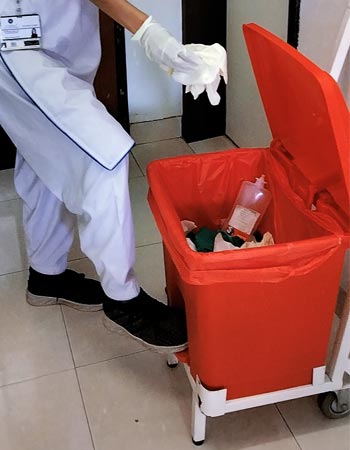Mobile red bin project to reduce incinerated waste on Stadium Road
 Rozina Roshan and Nazleen Virani are two of the nurse leaders involved in implementing an innovative practice for waste reduction at Stadium Road campus. They introduced the ‘mobile’ red bins in clinical areas which has led to at least 20% reduction in the amount of waste that goes for incineration.
Rozina Roshan and Nazleen Virani are two of the nurse leaders involved in implementing an innovative practice for waste reduction at Stadium Road campus. They introduced the ‘mobile’ red bins in clinical areas which has led to at least 20% reduction in the amount of waste that goes for incineration.
While the incineration of biohazardous waste is necessary to avoid contamination and is required by law, this process is also expensive and emission intensive. It not only consumes large amounts of energy but also produces harmful gases. This leads to local air pollution and contributes to climate change via the release of greenhouse gases. Innovation and local practice change are great ways to cut down on waste, energy, and emissions, as shown by the great work of our sustainability leaders.
The Office of Environment and Sustainability interviewed them to understand their inspiration, process, and hopes relating to sustainability at AKU. Read their story below.
What is the mobile bin project? How did it start and what was the process of implementation like?
It started with observing that not all waste was being properly disposed. Red bins are used for disposing infectious and hazardous waste such as supplies contaminated with blood and body fluids. This waste directly goes to the incinerator and is burned. While green bins are used for non-infectious waste such as packaging, food items, etc.
Some waste that belonged in the green bins was ending up in the red bins, which sent unnecessary amounts of waste for incineration. After identifying this non-compliance, a working team was formed which included members from Housekeeping, Infection Control, and Environmental Health and Safety departments. We sat down together and brainstormed possible solutions which led to the idea of placing the red bins on trolleys.
Now, the nurses could take the mobile red bins with them whenever they anticipated a procedure likely to create infectious waste. All nursing staff were provided regular and extensive training to implement the new idea. Even the leadership and unit management was taken on board.Only green bins were kept at the patient bedside, for the disposal of juice boxes, packaging, and the like.
This project was first piloted in C-1 ward in June 2020 and was gradually scaled to all the wards and critical care areas, except our Princess Zahra Pavilion where approval is currently pending.
What has been the impact on ground in terms of waste reduction and behavior change?
We are proud to share that as per the data collected, we have been able to reduce incinerated waste up to 40% since January 2022.
It took some time and a lot of effort to make this happen. We also faced some challenges. The biggest was behavior change. When people are used to doing things a certain way, it takes time and repeated sessions to get them to adopt something new.
The efforts are still ongoing. Compliance is ensured through daily rounds and monthly audits. We also reinforce the waste segregation training through monthly and quarterly sessions. We know that our efforts are working but the pace is slow. We are hopeful that with continuous training and improvement we can achieve further reduction in incinerated waste.
What other areas of your work can benefit from sustainability considerations?
Before, when we thought about saving the environment, we only thought of planting trees. But now we notice my surroundings and think about how we can decrease the waste and environmental impact.
At the start of the pandemic, when there was a shortage of PPEs (Personal Protective Equipment), we worked with vendors to supply not just disposable but also reusable gowns, and ordered 200 extra cloth gowns. We also worked with the Laundry and Linen Department to wash these cloth gowns. Now, the healthcare staff even prefer this over the disposable gowns. Thinking ahead, we should also consider and shift from disposable drapes and trays in the operating room to reusable ones to reduce waste.
What makes you hopeful about the work and the future of sustainability at AKU?
The future of sustainability is in teamwork. Basically, nobody can do everything on their own. It requires continuous efforts by all, and reinforcement should be done via teaching, education, and frequent audits.
Before, we were not aware about sustainability concepts. Nobody talked or cared about it. But now, people are talking and showing enthusiasm to be part of the change. The sustainability agenda is implemented from the President’s Office. This shows commitment and involvement from our leader to have a dedicated Environment and Sustainability Office and team working on this.
 Rozina Roshan
|
|  Nazleen Virani
|
|

